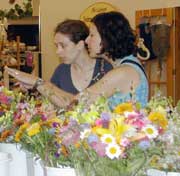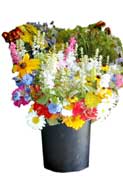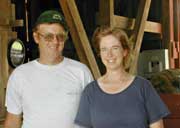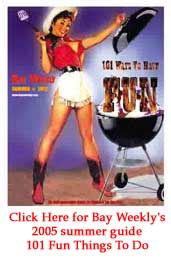|
|
 |
||
|
Volume 13, Issue 28 ~ July 14 - 20, - 2005
|
|||
 Raising Flowers in the Fields Where Tobacco Once Thrived Raising Flowers in the Fields Where Tobacco Once ThrivedFour agro-pioneers have turned from tobacco to cut-flower farming. story & photos by Janice F. Booth The glory of the garden, is more than meets the eye … —Rudyard Kipling White daisies peak like eager children from between the tall, lavender liatris; winged butterfly weed; gold-petaled black-eyed Susan. Along the lane, the beds of flowers flow in sinuous bands up over the rolling hill and down, then up again until the streams of flowers seem to spill into the wood at the far end of the distant field, making a river of moving color. Cut and bundled into bouquets, flowers are a new harvest of Chesapeake Country fields. For hundreds of years, many of these fields would have yielded the wide, green leaves of tobacco to be hung in the drying barns until they turned to brown, fragrant bundles. In our time, farming has changed. The Tobacco Road Not Taken If you wander into the countryside today — the rolling hills and red fields of St. Mary’s, Calvert, Charles, Prince George’s and Anne Arundel counties — you may stumble upon farms with names like Suttler Post and Wise Acres, JazzBerry and Upakrik, Crispens’ and Trott’s Farm. These history-laden tracts once grew Maryland’s coveted Type 32 tobacco. As recently as the 1980s, some 50,000 Southern Maryland acres yielded 40 million pounds of tobacco. Then, in 2001, Maryland turned its back on tobacco. With its health hazards undeniable, tobacco was rooted out of fields and farmers paid to give up the crop that was once as good as cash. Buyout money came from the National Tobacco Settlement, a federal fund created by rolling all future claims against the big-four cigarette manufacturers by 46 states and territories into one multi-billion-dollar settlement. In Maryland, farm owners who signed on to the buyout agreed to convert their agricultural production from tobacco to another crop. Payments of $1 per pound, to be paid over 10 years, were figured on each farmer’s average annual harvest from 1996 through 1998. To seal the deal, farmers also agreed to maintain some other sort of agricultural production on their farmland for their lifetime. In So  uthern Maryland, some 869 growers were paid $77 million to take some 7.7 million pounds of tobacco out of production. uthern Maryland, some 869 growers were paid $77 million to take some 7.7 million pounds of tobacco out of production.“The program was designed to save farmland for farming and preserve the quality of life in Southern Maryland,” said Christine Bergmark, director of the Southern Maryland Agricultural Development Commission. Today, that same land produces almost no tobacco. The demise of tobacco farming has turned farmers’ into agro-pioneers raising a variety of crops, livestock and other products, including grains; fruits; wine grapes; vegetables, organic and traditional; livestock — cattle, hogs and poultry but also llamas and emus; herbs and — for at least 26 farms — flowers. “The national statistics say cut-flower farming will earn $19,000 an acre, and that will top tobacco,” Bergmark told Bay Weekly. “Granted this is a different kind of management and marketing, while tobacco was pretty much one type with set places for market. But it’s potentially very lucrative.” An Elegant Solution Roxana Whitt and John Prouty of Wise Acres Farm in Huntingtown in Calvert County and Judy and John Mast of Suttler Post Farm in St. Mary’s County are among the agro-pioneers who have turned from tobacco to cut flower farming. Many American farmers, including the Masts and Whitt and Prouty hold full-time jobs off the farm. Judy Mast and Roxana Whitt work in offices; John Mast drives a truck; John Prouty practices law. Yet the work of cut-flower farming seems to enchant its practitioners. Soybeans and wheat have replaced tobacco as mainstays of Suttler Post Farm. In addition, the Masts saw the buyout as a chance to take a gamble, to try something new, even unorthodox. Why not cut flowers, Judy suggested. In a farm bulletin, she had seen a New York florist’s ad. The florist was seeking a farmer willing to grow a few acres of perennials and annuals. Seeds, advice and capital would come from the city florist; all they’d have to do would be plant, weed, water and harvest. Over the summer, the florist would collect the harvest to sell to flower-hungry city dwellers. So the Masts decided to take the chance. That first year, Suttler Post Farm planted two acres of flower seeds — coxcomb, zinnia, aster and phlox — just to see how the crop would take. The seeds took, and the Masts took to flowers. They quickly learned what made flowers salable: variety of petal and color, length of stem and blossoming time, longevity and profusion of the blossoms. The Masts took note, and by the end of their first year, they gave up on the city florist. They would choose their own flowers, do their own marketing and make their own mistakes. There were stumbles their second year, when they were on their own. With the city florist out of the equation, they had no markets for their bouquets and harvested more flowers than there were customers to buy them. John shot photos of pails full of cut flowers. “I’ve never again had such an opportunity to photograph our flowers,” he said. “That was the only time the bouquets didn’t sell as fast as we make them.” Cut-flower growing requires lots of manual labor, so the Masts had to figure out how to work smart and fast if they were going to turn a profit. Investment in a water-wheel planter and additional irrigation pumps eased the labor and improved their harvest. Like all experienced farmers, the Masts believed in their land and in their skill; they knew they would need to invest in their project. The payback: the fields of flowers and bundles of bouquets. Now four years into their farming venture, they have customers clamoring for their bells of Ireland, sunflowers, yarrow and daisies.  Sold on the Idea Sold on the IdeaAt Wise Acres Farm in Calvert County, Roxana Whitt and John Prouty reached the same crossroad. Prouty’s family had tilled their 200 acres since 1850. The barns for grain and tobacco were built with timber logged on Prouty land by Prouty forefathers. Along with the tobacco buyout, the Agricultural Land Preservation Act and Smart Growth Initiative of 2001 offered financial protection from increased taxes. Prouty and Whitt had only to commit to continue farming the land they love. With their land no longer on developers’ radar, fields would be farmed and harvests gathered without fear of foreclosure when times were tough. Whitt and Prouty focused on establishing a new crop for some of their acreage. For generations, tobacco was a small but valuable part of the harvest. Now, what crop would rise from the former tobacco fields? What would become of the tobacco-drying barn? The stripping room where the leaves were graded for market? The little red tractor whose wheels rolled between the tobacco rows? A replacement crop would have to fit their vision of Wise Acres Farm, named to reflect their commitment to wisely husbanding the land. Prouty loves this land where he and his ancestors were born and raised. Whitt’s birthright, a love for flowers and gardening, can be traced to her grandfather, Walter Scattergood, who designed landscapes in 19th century England. Her mother, Isabel Whitt, 85, still tends her own gardens. Whitt learned about flowers at her mother’s knee. “While other children read books about bikes and dolls,” Whitt says, “I read books about gardening and seed catalogs.” Like Judy Mast, Roxana Whitt had been looking for a door to open as that of tobacco farming closed. Then, in 1999, Whitt saw an ad for the Association of Specialty Cut-Flower Growers. The Association met in Boston that year, and Roxana and John were there. They listened to the presentations and discussed cut-flower farming as a plan for Wise Acres Farm. “We can do this!” Whitt said, and Prouty agreed. One glorious season of fields full of sunflowers, zinnia, daisies and snapdragons hooked them. In the spring of 2000, three-quarters of an acre shimmered with saffron yellow, coral, white and a dozen shades of pink. “Flowers are really about beauty,” Prouty says. “People enjoy them, and we enjoy both the flowers and the people. The satisfaction is beyond the monetary.” Science is on his side. At Rutgers University’s Human Development Lab, Professor Jeannette Haviland-Jones’ spent 10 months observing how people reacted to gifts of flowers. The Emotional Impact of Flowers study found both “immediate impact on happiness” and “long-term positive effect on moods.” “Common sense tells us that flowers make us happy,” reports Haviland-Jones. “Now, science shows that not only do flowers make us happier … they have strong positive effects on our emotional well being.” Like the long-time crop they replace in Southern Maryland fields, flowers are apparently psychoactive.  Labors of Love at Suttler Post Labors of Love at Suttler PostThe Masts raise their plants as they’ve reared their children, Katie, 16, and Josh, 18: with lots of tender care, patience, devotion and love. In four years, they’ve expanded Suttler Post’s flower farm from two to seven acres; they’ve added a greenhouse, a walk-in cooler, two tractors, a water-wheel planter and drip-irrigation. A golf cart named Flower Power was Judy Mast’s birthday gift from John and their children. Now, she zips along the field-lanes, keeping watch over her beloved acres of flowers. Beginning in mid-May every Thursday as the sun sets on Suttler Post Farm, the week’s harvest of blossoms is gently cut and gathered. Judy Mast knows just how many stalks of zinnia, sunflower, coxcomb and snapdragon must be cut to make up 50 buckets, each filled with five bouquets, for 250 bouquets per week. Each bouquet sells for $6. By Friday evening, the piles of blooms are rolled into vibrant bunches. Mast usually works with Katie and John, assembly-line fashion, preparing 25 bouquets per hour, until all the buckets are filled. The work must be done quickly to minimize stress to the flowers. Even so, it takes 10 hours to fill the 50 buckets for their weekend’s farmers’ markets. Before dawn on Saturday morning, the Masts load their van and drive to Silver Spring Farmers’ Market. From 9am until 1pm they’ll sell their flowers, then load up the empty buckets and drive home. Judy sleeps during most of the drive, having been up much of the previous night bundling the bouquets. Sunday morning finds the Masts driving to Tacoma Park for the Farmers’ Market that runs from 10am to 2pm. If you dashed down to Annapolis’ Market Square last summer to buy a fresh bouquet, those were Suttler Post Farm cut flowers you carried home for your table. Labors of Love at Wise Acres Wise Acres Farm has expanded its flower farming, too. This summer, two and a half acres are cultivated in flowers. Flower seeds and fertilizer are now sheltered in tobacco-drying barns, and the stripping room keeps finished bundles of flowers cool. Hoop-sheds that once protected tobacco seedlings now shield fledgling lilies and lisianthus. Four students work the flower fields with Prouty. Loren Snoddy, Katie Freeman, Ashley Cornwell and Mike Burton applied to work at Wise Acres after interviewing at the Calvert High School job-fair. “They’re great workers. I know they’ll be here every morning, ready to work,” Prouty says of his students. Former tobacco farmer Robert Chalmers also steps in to lend a hand when tasks pile up. Prouty has extended his commitment to the land in other ways, as well. He is vice-president of the Maryland Cut-Flower Growers. This fall at the 2005 Association of Specialty Cut-Flower Growers Conference in Lancaster, Pennsylvania, he will lecture on “How to get started [as a cut flower farmer] and still like yourself afterward.” Mornings on Wise Acres Farm begin with harvesting. Today, perhaps it’s the lavender or zinnia whose buds are ready to unfold. Catching the buds early, with the dew still on the leaves, extends the life of the flowers. Each variety usually blooms for a few weeks. The harvesting must be done by hand, with long, sharp knives that won’t damage the sometimes-fragile stems. Cutting a bloom less than eight inches makes that flower too short for gathering into a bouquet. Once harvested, the flower buds are tucked into freshly washed containers of cool water and moved into the shady barn. There they’ll wait quietly until Friday, when Whitt and her team mix the opening blooms into glorious and varied bouquets. Larkspur and daisy, phlox and astilbe rolled in with some greens and ornamental grass — and the bouquets are ready for market. Every weekend they sell 200 to 225 bouquets. “Customers know our flowers,” Prouty explains. Wise Acres sells every bouquet they gather; prices vary from $8 to $13 per bouquet. The Calvert Country Market, Bowens Store in Huntingtown and occasionally one of the local farmer’s stands sell Wise Acres bouquets. Sometimes Prouty and Whitt agree to prepare bouquets for special orders such as birthdays and anniversaries. Wise Acres Farm has no plan to increase its flower production beyond the almost three acres grown now. “We’re as big as we’re ever gonna’ get,” says Prouty. “There’s more than enough work to do.”  A Time to Every Season A Time to Every SeasonLike most labors of love, growing flowers is both satisfying and demanding. When the harvest is done, the weed barriers are pulled up, the irrigation hoses inspected and repaired, the fields tilled and tidied. John Prouty loves farming, but he admits looking forward to fall’s first frost, which ends the cut-flower selling season. “We get to do some traveling once the frost hits,” he says. For Whitt and him, traveling includes helping organize and attending all the Association of Specialty Cut-Flower Growers Conferences. For the Masts, fall frost means they can turn their attention to their family and tasks that have had to wait during the busy, fertile summer months. As the leaves pile up on the lawn, seed and nursery catalogues gather in the mailboxes at Suttler Post and Wise Acres. Another year’s order must be made, old favorites and exotic new blooms selected and paid for. They order for variety and color. As Mast says, “customers want some surprises, something different.” Orders include unique flowers to surprise and old favorites to charm. “Every year I add something new and special,” Judy Mast says, for she’s learned that customers like novelty in their bouquets. “They don’t want to see the same flowers week-after-week.” They order for a long growing season, for their fields must produce lush, colorful, sturdy blossoms all summer long, from May until October. Anticipation mounts as Whitt debates planting gomphrena; Prouty hates their short stalks and tiny flowers. Judy Mast worries whether they should invest in the two-tone lisianthus or stick with the lush purple variety her customers so admire. Costs must be weighed against profits: $6 or $8 per bouquet against the costs of seeds, fertilizer, heat for the greenhouses. When Wise Acres sends off its winter order, it usually includes 100 varieties of flowers: 5,000 seedlings, 5,000 bulbs and the equivalent to 300 packets of seeds. As with farmers for ages, money and time are invested long before there’s any hope of seeing a profit. By February, greenhouses are heated and life begins for the seedlings. No one’s counting the hours of labor, coaxing the tiny shoots to grow tall and strong, capable of carrying the weight of the blossoms they’ll soon display. Orders of seeds, seedlings and bulbs arrive in boxes and crates. The fields of Suttler Post and Wise Acres Farms will be jostled and prodded like sleepy children awaking from a winter’s nap. The earliest seedlings are set in February. So as late-winter snows compete with spring showers, the work of the cut-flower farmer begins again. It’s not tobacco, but it may grow into a healthier crop for Marylanders.
|
|||
|
|
|||
|
© COPYRIGHT 2004 by New Bay Enterprises, Inc. All rights reserved. |


 About the Author
About the Author